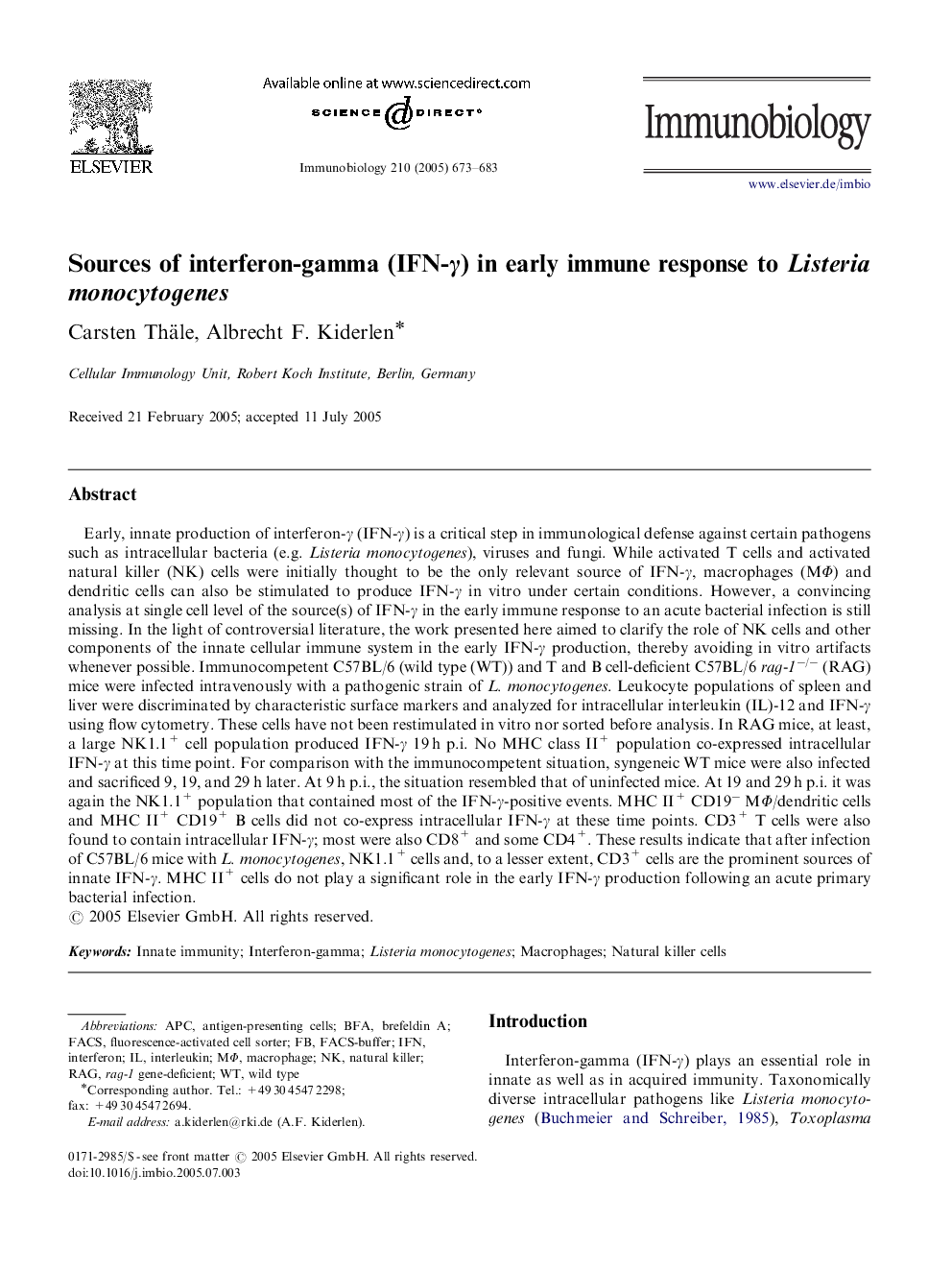| کد مقاله | کد نشریه | سال انتشار | مقاله انگلیسی | نسخه تمام متن |
|---|---|---|---|---|
| 10941278 | 1095649 | 2005 | 11 صفحه PDF | دانلود رایگان |
عنوان انگلیسی مقاله ISI
Sources of interferon-gamma (IFN-γ) in early immune response to Listeria monocytogenes
دانلود مقاله + سفارش ترجمه
دانلود مقاله ISI انگلیسی
رایگان برای ایرانیان
کلمات کلیدی
RAGFACSAPCBFAnatural killer - (سلول های) کشنده طبیعیMϕ - Mφantigen-presenting cells - آنتیژن ارائه سلولInnate immunity - ایمنی ذاتیinterferon - اینترفرونIFN - اینترفرون هاinterferon-gamma - اینترفرون گاماinterleukin - اینترلوکینbrefeldin A - برفلدین ANatural killer cells - سلولهای کشنده طبیعیfluorescence-activated cell sorter - فلورسانس فعال سلول مرتب سازListeria monocytogenes - لیستریا مونوسیتوژنزMacrophage - ماکروفاژ Macrophages - ماکروفاژها،درشت خوارهاwild type - نوع وحشی
موضوعات مرتبط
علوم زیستی و بیوفناوری
بیوشیمی، ژنتیک و زیست شناسی مولکولی
بیولوژی سلول
پیش نمایش صفحه اول مقاله

چکیده انگلیسی
Early, innate production of interferon-γ (IFN-γ) is a critical step in immunological defense against certain pathogens such as intracellular bacteria (e.g. Listeria monocytogenes), viruses and fungi. While activated T cells and activated natural killer (NK) cells were initially thought to be the only relevant source of IFN-γ, macrophages (MΦ) and dendritic cells can also be stimulated to produce IFN-γ in vitro under certain conditions. However, a convincing analysis at single cell level of the source(s) of IFN-γ in the early immune response to an acute bacterial infection is still missing. In the light of controversial literature, the work presented here aimed to clarify the role of NK cells and other components of the innate cellular immune system in the early IFN-γ production, thereby avoiding in vitro artifacts whenever possible. Immunocompetent C57BL/6 (wild type (WT)) and T and B cell-deficient C57BL/6 rag-1â/â (RAG) mice were infected intravenously with a pathogenic strain of L. monocytogenes. Leukocyte populations of spleen and liver were discriminated by characteristic surface markers and analyzed for intracellular interleukin (IL)-12 and IFN-γ using flow cytometry. These cells have not been restimulated in vitro nor sorted before analysis. In RAG mice, at least, a large NK1.1+ cell population produced IFN-γ 19 h p.i. No MHC class II+ population co-expressed intracellular IFN-γ at this time point. For comparison with the immunocompetent situation, syngeneic WT mice were also infected and sacrificed 9, 19, and 29 h later. At 9 h p.i., the situation resembled that of uninfected mice. At 19 and 29 h p.i. it was again the NK1.1+ population that contained most of the IFN-γ-positive events. MHC II+ CD19â MΦ/dendritic cells and MHC II+ CD19+ B cells did not co-express intracellular IFN-γ at these time points. CD3+ T cells were also found to contain intracellular IFN-γ; most were also CD8+ and some CD4+. These results indicate that after infection of C57BL/6 mice with L. monocytogenes, NK1.1+ cells and, to a lesser extent, CD3+ cells are the prominent sources of innate IFN-γ. MHC II+ cells do not play a significant role in the early IFN-γ production following an acute primary bacterial infection.
ناشر
Database: Elsevier - ScienceDirect (ساینس دایرکت)
Journal: Immunobiology - Volume 210, Issue 9, 15 November 2005, Pages 673-683
Journal: Immunobiology - Volume 210, Issue 9, 15 November 2005, Pages 673-683
نویسندگان
Carsten Thäle, Albrecht F. Kiderlen,